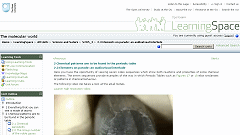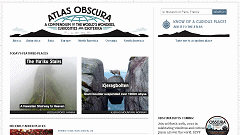 1. Chemistry Videos and Many, Many Other Educational Goodies
1. Chemistry Videos and Many, Many Other Educational Goodies
The Open University is a venerable institution in the U.K.; established in 1969, its goals are to provide adult education—in pretty much any discipline you care to name—to anyone who wants it, regardless of the person's previous academic experience, success, or lack thereof. Or location. Not surprisingly, the university has a wealth of materials available online. I'm linking to one such sample, partly because it's an excellent and informative video but also because it involves the sequence of alkali metals and what happens when they meet water. To quote the narrator, "you can see that things gradually become more terrifying as we go down the group."
 2. Atlas Obscura: Strange and Wonderful Places and Sights
2. Atlas Obscura: Strange and Wonderful Places and Sights
The Atlas Obscura is a compendium of beautiful, odd, strange, or outlandish locations around the world. Churches made of bones, caves filled with crystals, monasteries built into mountainsides, quirky museums, odd houses, gardens, statues, and markers, all can be found in the atlas. Each entry includes photographs and background information as well as links to any online sources as well as maps and directions if available. It's a very fun site to browse!
New to Bookshelves
 Wireless Sensor Networks for Healthcare Applications
Wireless Sensor Networks for Healthcare Applications
Authors: Terrance J. Dishongh and Michael McGrath
Publisher: Artech House
ISBN: 978-1-59693-305-7
Page count: 246
This hardcover book amasses a wealth of information about wireless sensor networking for healthcare, particularly its application to healthcare delivered in a home setting. The authors, who have been working in this field for 10 years, share what they've learned.
The book is split into 10 chapters and the first chapter is devoted to the rationale for the book itself, examining how our changing demographics will impact our healthcare systems and how wireless sensor networks (WSNs), by moving the point of care to the home, can help to address the medical needs of an aging population.
Chapter 2 focuses on the technologies involved in WSNs, including the various types of WSN platforms and network architectures. Chapter 3 examines how to develop the system to meet the needs of both the clinicians and the ultimate end user, while Chapter 4 covers how to select the best-fit technologies, including discussion of field experiences with radio enclosures and Bluetooth testing. Chapter 5 is devoted to data collection and decision making while Chapter 6 covers how to deploy your WSN in the field.
The next three chapters are case studies. Chapter 7 is a case study of developing and using a WSN for gait variation monitoring, used to identify those people who are most vulnerable to falling. The case study in Chapter 8 talks about using a WSN to ensure adherence to medication regimens and Chapter 9 discusses a WSN used to monitor social activity as a marker of well-being. Finally, Chapter 10 talks about the future of WSNs for healthcare.
The book is clearly written and it is packed with information, including rafts of pictures and tables and diagrams to illustrate important points. Most importantly (in my view, anyway) is its focus on how to use the technology to solve a series of real problems and to develop designs that work both for the people assessing the data and for the patients.